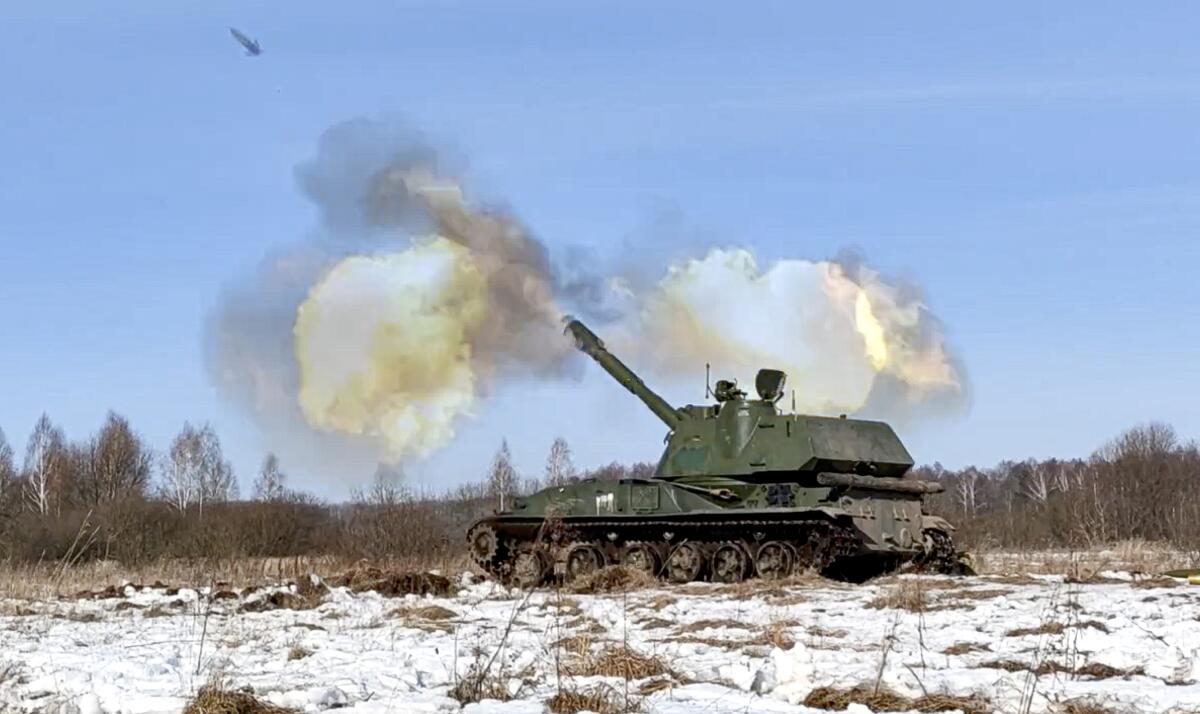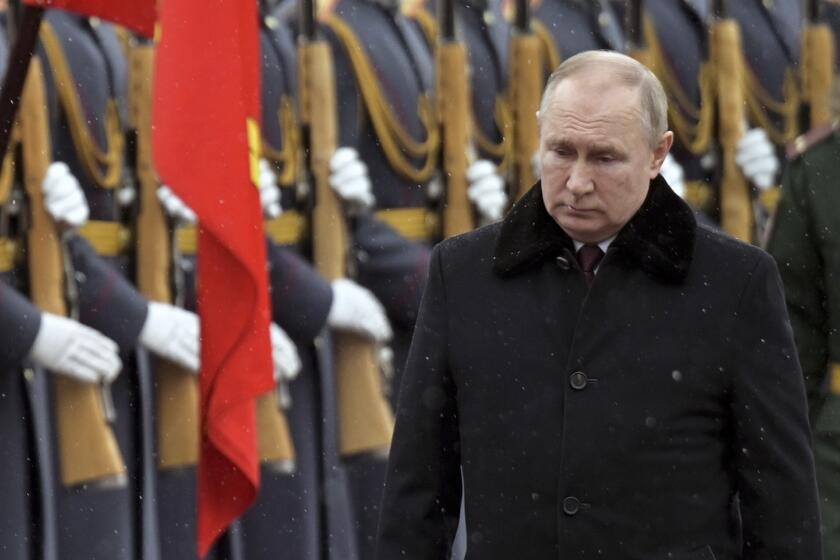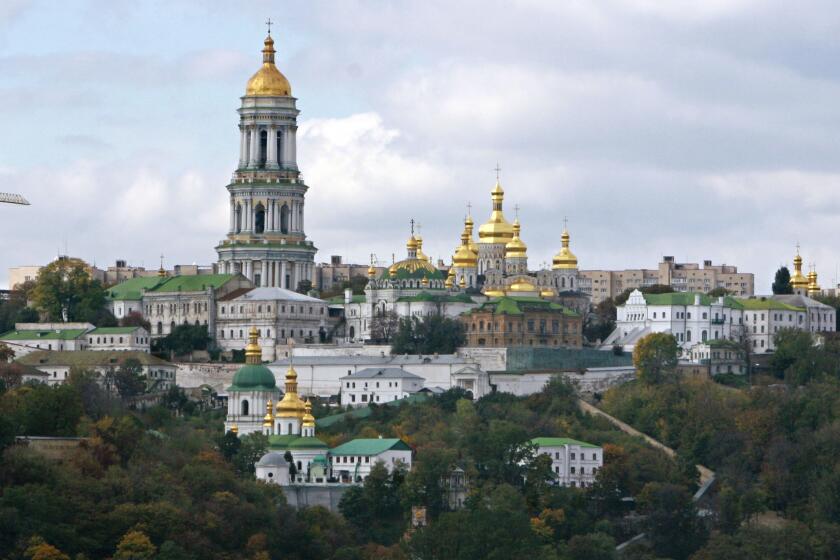Hypersonic missiles are the latest weapons added to Russia’s vast arsenal in Ukraine

- Share via
MOSCOW — The Russian invasion of Ukraine is the largest conflict that Europe has seen since World War II, with Russia conducting a multi-pronged offensive across the country.
The Russian military has pummeled wide areas in Ukraine with airstrikes and has conducted major rocket and artillery bombardments, resulting in large numbers of casualties. But Russian forces have yet to capture strategic cities such as Kyiv or Kharkiv, leading President Biden and others to warn that Moscow could turn to deadlier weapons such as hypersonic missiles or even to chemical and biological attacks to subdue Ukraine.
Here’s a look at some of the weapons being used in the conflict.
Warplanes and missiles
The Russian military has used warplanes and different types of missiles to strike facilities throughout the country. Civilian targets are also increasingly being hit.
On Saturday, the Russian military said it had deployed its Kinzhal, or Dagger, aviation missile system with hypersonic aero-ballistic missiles for what was believed to be the first time since its invasion of Ukraine began Feb. 24. Hypersonic missiles can fly at up to 10 to 15 times the speed of sound.
The U.S., China and North Korea are all working on developing hypersonic missiles, whose speed makes them more effective at evading missile-defense systems.
“It’s almost impossible to stop it. There’s a reason they’re using it,” Biden said of Russian troops in Ukraine.
The Kalibr cruise missile is a precision weapon, but Ukrainian military facilities and government buildings apparently targeted by those missiles in Kyiv and Kharkiv are close to residential areas, resulting in civilian casualties.
Through the Cold War and the decades since, nothing could persuade Finns and Swedes that they would be better off joining NATO — until now.
The same applies to missiles carried by Russian warplanes, which targeted military infrastructure in strikes that also involved so-called collateral damage.
To hit key targets, the Russian military also has used Iskander missiles that have a range of up to around 300 miles and carry a much more powerful warhead that can destroy big buildings and some fortified facilities. Some Iskander missiles were reportedly fired from the territory of Russian ally Belarus, which has served as a staging ground for the Russian invasion.
Rocket and artillery
Ukrainian President Volodymyr Zelensky and other officials have accused the Russian military of indiscriminately shelling residential buildings, schools and hospitals around the country.
Independently verified images from Ukraine’s second-largest city, Kharkiv, showed what appeared to be a barrage of Russian rockets hitting residential buildings in an attack that killed and wounded scores of civilians.
The Soviet-designed Grad (Hail), Smerch (Tornado) and Uragan (Hurricane) multiple-rocket launchers are designed to fire a salvo of powerful rockets to destroy concentrations of troops or military equipment. Their use against populated areas inevitably causes heavy casualties and major damage to civilian infrastructure.
The Russian president is believed to be very wealthy, but his assets are in the name of relatives, associates and friendly oligarchs.
The Russian military also has a wide range of powerful Soviet-designed artillery units, which were bizarrely named after flowers, such as the self-propelled 203-mm Peony and 152-mm Hyacinth and Acacia self-propelled howitzers.
Moscow has claimed that its forces are targeting only military bases and infrastructure, but the Associated Press has documented massive damage to civilian infrastructure and residential areas in Kyiv, Kharkiv, Mariupol and numerous other cities and towns across Ukraine. Russian officials have alleged that Ukrainian forces have widely deployed heavy weapons in residential areas to use civilians as shields, a claim that couldn’t be independently verified.
Cluster munitions and thermobaric weapons
Ukrainian officials have accused Russia of using cluster munitions, accusations that the Kremlin has denied.
Such weapons are designed to target enemy troops and weapons over a broad area, and their use in populated areas inevitably would lead to mass casualties among civilians.
Kyiv is the spiritual as well as governmental heart of Ukraine, home to some of the nation’s most sacred Orthodox shrines.
Cluster bombs, rockets and artillery shells open in the air, releasing submunitions, or “bomblets,” that are dispersed over a large area and simultaneously hit multiple targets.
Beyond the initial impact, bomblets have a high rate of failure of exploding immediately, and therefore pose a threat of killing and maiming people long after they are fired.
Thermobaric weapons consist of a fuel container and two separate explosive charges, with the first detonating to disperse the fuel particles and the second igniting the dispersed fuel and oxygen in the air, creating a blast wave of extreme pressure and heat that creates a partial vacuum in an enclosed space. That makes the weapon particularly deadly for people in an enclosed space.
The Pentagon has said that Russian mobile launchers for thermobaric weapons were spotted inside Ukraine, but couldn’t confirm their use.
Ukraine’s arsenal
The Ukrainian military has relied on the same assortment of Soviet-built multiple-rocket launchers and howitzers that the Russian military has.
It doesn’t possess sophisticated long-range precision weapons like Russia’s Iskander ballistic missiles or Kalibr cruise missiles.
In a basement beneath Kyiv, Ukrainians form an assembly line to craft Molotov cocktails to use against Russian tanks.
The Ukrainian military has Soviet-era Tochka-U short-range ballistic missiles, which have a powerful warhead but poor precision compared with the latest Russian weapons.
In addition to its aging Soviet-made arsenals, Ukraine has received large shipments of Western weapons, such as U.S.-made Javelin anti-tank missiles and shoulder-launched Stinger anti-aircraft missiles. Ukrainian officials said the country’s military has used them to inflict heavy casualties on the invading Russian forces.
The Ukrainian military also has used Bayraktar drones supplied by Turkey before the conflict. It has released a video showing an attack by a Bayraktar drone against a Russian military convoy.
Times staff writer Henry Chu in London contributed to this report.
More to Read
Sign up for Essential California
The most important California stories and recommendations in your inbox every morning.
You may occasionally receive promotional content from the Los Angeles Times.














